|
These "gems" (Mound
72 Points) were undoubtedly a display
of wealth and prestige."---------1999,
Melvin L. Fowler, Jerome Rose, Barbara Vander Leest & Steven R. Ahler, "A
Commemoration of Chiefly Power and Sacred Space, chap. 14," The
Mound 72 Area: Dedicated and Sacred Space in Early Cahokia," p. 170.
"Among these grave goods (in
Mound 72) were several hundred
arrowheads of very fine workmanship, separated into distinct categories.
Among the categories (of arrowheads)
were shapes and materials indicating relationships between Cahokia and
areas as far away as Oklahoma, Tennessee, southern Illinois, and
Wisconsin."---1989, Melvin Fowler, "The
Cahokia Atlas, A historical Atlas Of Cahokia Archaeology," p. 150.
"An examination of arrow points from all three caches in Mound
72 at Cahokia revealed an interesting presence of Kaolin chert,
comprising approximately 9% of the total."---2007,
Jack H. Ray, "Ozarks Chipped-Stone Resources: A Guide To The
Identification, Distribution, And Prehistoric Use Of Cherts And Other
Siliceous Raw Materials," p. 246.
"Certainly other
forms and meanings were co-opted from distant sources and hybridized
with local local ones, nicely embodied in an array of projectile points
from Mound 72 made by someone who mixed Cahokia style attributes with
those of Bayogoula and Hayes styles from Coles Creek-Plaquemine region
of Louisiana and southern Arkansas."---2004,
Timothy R. Pauketat,
"Ancient Cahokia And The Mississippians," pp. 91 and 113.
"Excavations through the mound (mound
72) indicated that it had been
constructed as a series of smaller mounds that were then reshaped and
covered over to give the mound its final shape."---1989,
Melvin Fowler, "The Cahokia Atlas, A historical Atlas Of Cahokia
Archaeology," p. 148.
"----the entire sequence of events at Mound
72 could have taken place within a span of 100 years."---1999,
Melvin L. Fowler, Jerome Rose, Barbara Vander Leest & Steven R. Ahler,
"The
Mound 72 Area: Dedicated and Sacred Space in Early Cahokia," p. 105.

MOUND 72 POINTS
A.D. 1000
CAHOKIA MOUNDS STATE HISTORIC
SITE
ST. CLAIR COUNTY, ILLINOIS
Mound 72 was built in
stages over a series of smaller mounds over a long period of time. The
site began as a marker post and later a burial site where 252 people
were buried. Some of them were high status individuals but most were
sacrificial offerings. A large number of artifacts were found during the excavation.
The most impressive of these are hundreds of finely crafted arrow
points.
|
|

CLICK ON PICTURE FOR LARGER IMAGE
OWNED BY THE PEOPLE OF ILLINOIS
MOUND 72 POINTS
A.D. 1000
CAHOKIA MOUNDS STATE HISTORIC
SITE
ST. CLAIR COUNTY, ILLINOIS
This picture shows many of the unique forms of arrow points that
were found in Mound 72. Most of Fowler's identified types can be
seen in this picture. Many of the colorful red and yellow points are
made of Kaolin chert from southern Illinois. Most of the Mound 72
points were made of white Burlington chert. Other cherts in this
picture are Mill Creek, the high Ridge variety of Burlington, Elco
or Dover/Fort Payne, and quartzite that may either be Hixton from Wisconsin or
from another reported source of quartzite closer to the Cahokia Mounds site. The longest point
is the red serrated Madison just left of center. It measures 2 13/16
inches (7.1 cm) long. The shortest point is the white triple-notched
Cahokia point at lower right that appears to have been resharpened.
It measures 15/16 of an inch (2.4 cm) long. |
|
|
The purpose of the
excavation of Mound 72 in 1967 through 1971 was to investigate why it held such an
important position with its orientation and alignment to other mounds at
Cahokia. The project was called the Cahokia Mapping Project. The
excavation was done by the University of Wisconsin-Milwaukee to classify
and map various mounds at Cahokia. The excavation revealed two pits
where large posts once stood. One of them is estimated to have been
three feet in diameter and had been placed eight feet into the ground.
It was also surrounded by small cedar logs that secured it in place. The large
post had been removed but the smaller logs still remained. Samples taken
from the logs produced a radio carbon date of A.D. 1000. |
|

OWNED BY THE PEOPLE OF
ILLINOIS
MOUND 72
PROJECTILE POINT TYPES
A.D. 1000
CAHOKIA MOUNDS STATE HISTORIC
SITE
ST. CLAIR COUNTY, ILLINOIS
These eleven points from Mound 72
represents Fowler's cataloged point types. He designated them by
Roman numerals from I to XI. He also lists 18 sub-types which
indicates of how complex the design patterns are. |
|
|
Mound 72 is one of
eight ridge-top mounds located on the Cahokia Mounds site. The fact that
Mound 72 was once the location of
two large marker posts indicates that it held an important position
in relation to other mound features at Cahokia. Mound 72 was constructed
over a series of smaller mounds over a period of time that may have
lasted for a hundred years. The first mound was built over a
large post pit that still contained some of its original bracing logs.
This mound
contained a burial of an
important individual who was laid out on a bed of shell beads in the
shape of a bird. The mound also contained several other burials that
seem to have been sacrificial offerings along with other grave goods. A
second small mound was also built over another large post pit along with
an important individual who was also buried with several grave goods and
burials. A third mound was constructed between the first two mounds and
was built over a large burial pit containing over 53 young women ages 15
to 30 and four males with heads and hands removed.
The final stage of
construction at mound 72 was the encapsulation of all three initial
primary mounds with one large ridge-top mound. The orientation of the
ridge is along the solstice angle. |
|

CLICK ON PICTURE FOR LARGER IMAGE
OWNED BY THE PEOPLE OF
ILLINOIS
NUMBER
1550 CACHE OF POINTS
MOUND 72
A.D. 1000
CAHOKIA MOUNDS STATE HISTORIC
SITE
ST. CLAIR COUNTY, ILLINOIS
This picture
shows one of the two caches of arrow points recovered from primary mound
1. It contains 332 points and it has
the highest number of different point types. Fowler identified nine out of
a total of eleven different types in this cache. The most common
type is represented by 108 black (type X) Scallorn points made of
Pitkin chert. The next highest number is represented by 91 (type
VII) serrated Madison points made of Burlington, Mill Creek and
Kaolin cherts. The third highest number are 69 (type I) triple-notched
serrated and un-serrated Cahokia points made
from white Burlington, pink High Ridge variety of Burlington and a brown chert
that is either Elco or Dover/Fort Payne chert. There were also 37 (type
IX) double-notched serrated points in this cache, 14 (type V)
un-named corner-notched recurved blade edge points, 8 (type XI) un-named
triple-notched edge and base serrated points, 3 (type IV) un-named wide
corner-notched points, 1 (type VIII) triple-notched serrated Cahokia
point, and 1 (type III) Agee point. The longest point is the red
serrated Madison at lower left, it measures 2 13/16 inches (7.1 cm)
long. |
|
|
The excavation of Mound 72
produced a large number of artifacts that were made from a wide range of
materials. The site preserved many organic artifacts made of antler,
bone, shell and wood plus more durable artifacts made of fired clay,
copper and stone. Some of these materials were found
in the form of, 2,211 sherds from 110 ceramic vessels, 14 chunky stones,
60,000 shell beads, 10 copper beads, some beads made of bone, two
bushels of un-worked mica, one roll of sheet copper measuring about one
meter in length, copper ear spools and one made of pipestone, one bone
needle, 1,196 stone arrow points, bone harpoons, and more than a hundred antler
arrowpoints. Also, several small stone tools were found in the form of
flakes, micro-drills, micro-drill cores, unifacial tools, abraders, etc. |
|
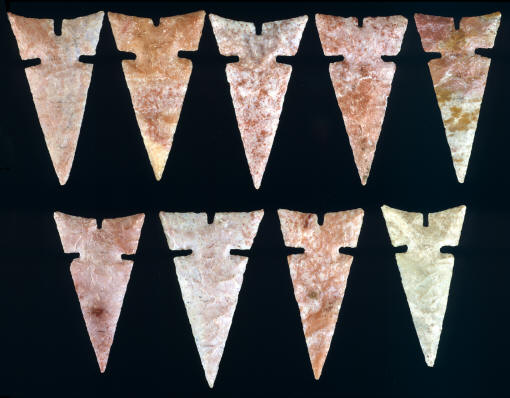
CLICK ON PICTURE FOR LARGER IMAGE
OWNED BY THE PEOPLE OF
ILLINOIS
TRIPLE-NOTCHED CAHOKIA
POINTS
MOUND 72
A.D. 1000
CAHOKIA MOUNDS STATE HISTORIC
SITE
ST. CLAIR COUNTY, ILLINOIS
These colorful triple-notched Cahokia
points were found in cache number 1550. Only 19 or 20 points were
found like these. They are made of the High Ridge
variety of Burlington chert. These are very thin well made points.
The longest point measures 1 5/8 inches (4.1 cm) long. |
|
|
Four large caches of
arrow points were discovered in Mound 72. Three of the caches were made
of stone and one cache was made of antler. The stone points are
remarkable for their fine craftsmanship, diversity of materials and
their wide range of artistic shapes. Many of these points do not conform to any known point type.
But their styles hint at known types from Cahokia and other regions around Cahokia to the west and south. |
|

CLICK ON PICTURE FOR LARGER IMAGE
OWNED BY THE PEOPLE OF
ILLINOIS
NUMBER 1970 CACHE OF
POINTS
MOUND 72
A.D. 1000
CAHOKIA MOUNDS STATE HISTORIC
SITE
ST. CLAIR COUNTY, ILLINOIS
Cache
number 1970 was found in primary mound number 2 in the northwest
section of mound 72.
With a total of 451 arrow points
in this cache it's the largest cache of points that was found. Only
four different point types were identified in this cache. The point
type with the highest number has 258 (type I) triple-notched
serrated and un-serrated Cahokia
points made of white Burlington chert. The second largest number is 178 (type VII) serrated Madison
points most of which are made of Kaolin chert. The third largest number is
represented by 13 (type VIII) triple-notched serrated Cahokia points and
the fourth type has 2 (type IX) double-notched serrated Cahokia points.
These points were apparently once held in a container made of
some type of organic material that did not survive. A few bone
harpoon points can be seen scattered around the edges of the cache. |
|
|
The Mound 72 arrow points are most important because they
illustrate a strong connection to other Mississippian sites to the south
and west. It's obvious that the Caddoan culture is well represented.
Quite a few of the points were made into fanciful designs. These
"exotic" points have attributes that relate to arrow point styles from
other regions. Locally made Cahokia points do not have the recurved
blade edges or corner notching design themes that many of them have.
Fowler writes that, "----the artisans who made the Mound 72 specimens
may have intentionally mixed morphological elements to create shapes of
points that were unique and not to be encountered in utilitarian
contexts. This may have been done to further enhance the ritual
significance or meaning of the projectile points in relation to their
social context of disposition in Mound 72." |
|
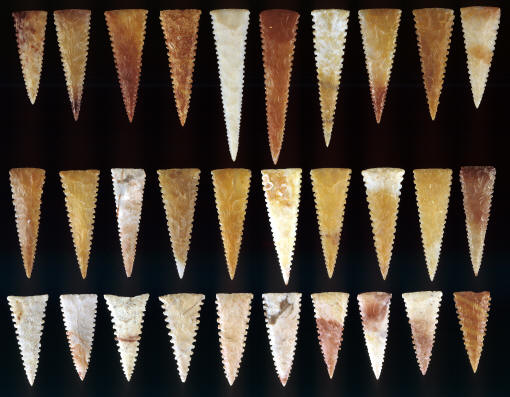
CLICK ON PICTURE FOR LARGER IMAGE
OWNED BY THE PEOPLE OF
ILLINOIS
SERRATED MADISON POINTS
MOUND 72
A.D. 1000
CAHOKIA MOUNDS STATE HISTORIC
SITE
ST. CLAIR COUNTY, ILLINOIS
These serrated
Madison points represent the second most common point type found in
the three caches of points in Mound 72. Fowler reports six different
variations of the type for a total of 326 points. Over a hundred of
them were made of Kaolin chert. Other examples in the cache are made of
Burlington and Mill Creek cherts. Serrated Madison points are found on habitation sites but they
are rare. So the largest collection of these points come from Mound 72.
The longest point is the red serrated Madison point at top row
center. It measures 2
13/16 inches (7.1 cm) long. |
|
|
Fowler identifies
eleven main types of points in the Mound 72 caches. He designates them
by Roman numerals from I to XI. He also lists 18 sub-types which
indicates how complex the design patterns are. |
|
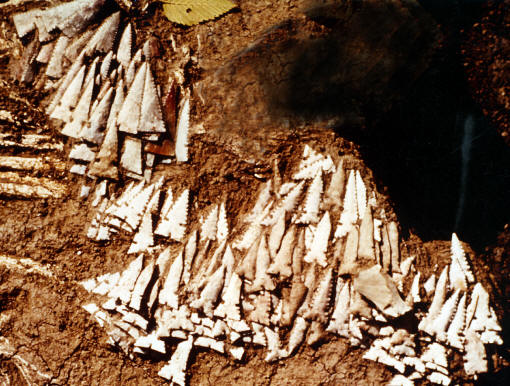
CLICK ON PICTURE FOR LARGER IMAGE
OWNED BY THE PEOPLE OF
ILLINOIS
CACHE NUMBER 1551
MOUND 72
A.D. 1000
CAHOKIA MOUNDS STATE HISTORIC
SITE
ST. CLAIR COUNTY, ILLINOIS
This picture shows
cache number 1551.
It was found in primary
mound number 1 with a burial in feature number 102. The cache was
placed around the head of an individual. All
of the points in this cache were laying in one direction and were
apparently once attached to arrows.
There are 337 points and six different point types in this cache.
The most common type in this cache are 188 (type XI) unnamed
triple-notched serrated points that have recurved blade edges and are
made of white Burlington chert.
The next most common type in this cache is represented by 102 (type
I) triple-notched serrated and un-serrated Cahokia points. The third largest number of points
are represented by 57 (type VII) Madison serrated points made of
Kaolin, white Burlington and possibly Mill Creek chert. There are
also 17 (type VI) Madison points, 9 (type VIII) triple-notched
serrated Cahokia points, and 4 (type II) triple-notched points in
this cache. |
|
|
The three caches of stone points
that were discovered in Mound 72 are designated as cache
numbers 1550, 1551 and 1970. Both of the 1550 and 1551 caches were
discovered during the first season of excavation in 1967 and were found
in the first primary mound. Each cache was arranged around a separate
burial. The 1550 cache was laid around the legs of one individual and
the 1551 cache was laid around the head of another individual. All of
the points in these two caches were laying in one direction and were
apparently once attached
to arrows. They were placed there either in bundles or quivers. |
|
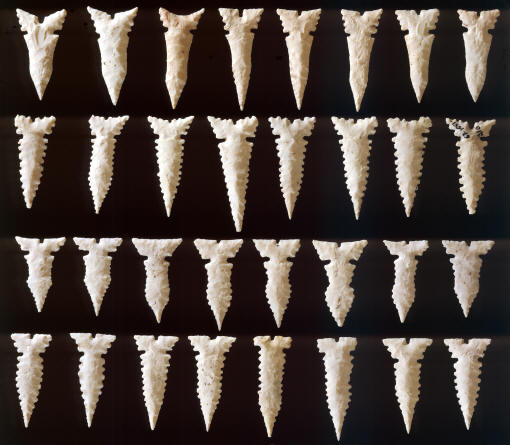
CLICK ON PICTURE FOR LARGER IMAGE
OWNED BY THE PEOPLE OF
ILLINOIS
"EXOTIC FORMS" OF MOUND 72
POINTS
A.D. 1000
CAHOKIA MOUNDS STATE HISTORIC
SITE
ST. CLAIR COUNTY, ILLINOIS
These are some of the most artistic and "exotic"
forms of Mound 72 points. All of them are triple-notched and have
serrations somewhere along their edges or bases. Fowler designates
these as type XI points. He compares their triple-notched bases with
Huffaker points but admits that is where the similarity ends. He
comments that "The type XI points thus do not compare favorably with
any single described point type of cluster." Pauketat refers to
some of these points as "hybrid" projectile points and compares them
to a Bayogoula point from the Grossmann site. These points appear as
though the craftsman was told to make them in the most artistic and
fanciful way. He did it by combining and exaggerating several
different design features from Caddoan and Cahokia point types. The
small needle points and recurved blade edges are features that can
be found on some Caddoan points but not, or very rarely, on any
Cahokia point types. The triple-notching and serrations are features
that are more likely found on Cahokia type points. All of these points are made of white
Burlington chert. |
|
|
Cache number 1550 has the highest number of different point
types. Fowler identified nine out of a total of eleven different types
in this cache.
Cache number 1550 contains 332 arrow points. The most common type in
this cache is represented by 108 black (type X) Scallorn points made of
Pitkin chert. The next highest number is represented by 91 (type VII)
serrated Madison points made of Burlington, Mill Creek and Kaolin
cherts. The third highest number are 69 (type I) triple-notched serrated
and un-serrated Cahokia points made
from white Burlington, pink High Ridge variety of Burlington and a brown chert
that is either Elco or Dover/Fort Payne chert. There were also 37 (type
IX) double-notched serrated points in the cache, 14 (type V)
un-named corner-notched recurved blade edge points, 8 (type XI) un-named
triple-notched edge and base serrated points, 3 (type IV) un-named wide
corner-notched points, 1 (type VIII) triple-notched serrated Cahokia
point, and 1 (type III) Agee point. |
|
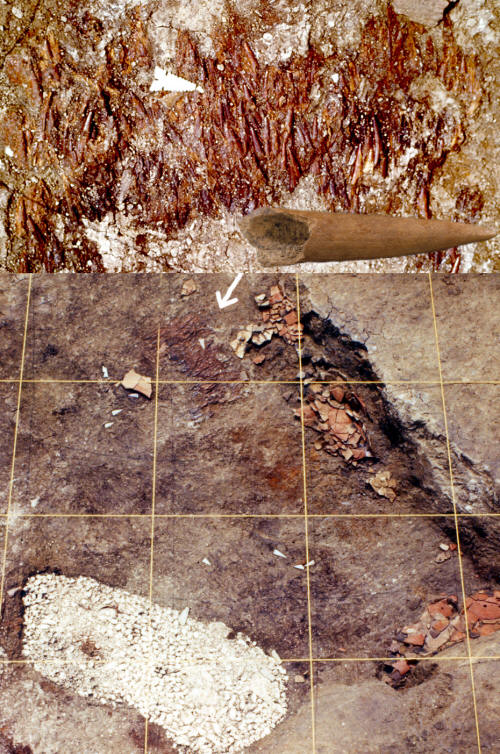
CLICK ON
PICTURE FOR LARGER IMAGE
OWNED BY THE PEOPLE OF
ILLINOIS
ANTLER POINT CACHE
MOUND 72
A.D. 1000
CAHOKIA MOUNDS STATE HISTORIC
SITE
ST. CLAIR COUNTY, ILLINOIS
One cache of antler arrow points was
found in Mound 72 in feature number 236. The picture at top shows a
close up view of the cache and the bottom picture shows a wider view of the excavated area
around the cache. The arrow is pointing to the cache.
It appears as though there is well over a hundred points in this
cache. The points are laying parallel to each other so they were
probably once hafted onto shafts. Many of them seem to be typical
examples that have a single barb on their bases. The picture at top
shows an enlarged image of one of the points that has a damaged
base.
The lower picture also shows several broken red slipped ceramic
pot sherds and a very large cache of shell beads. A few stray stone arrow
points can also be seen in the picture. |
|
|
Cache number 1551 contains 337 points and six different
types. The most common type in this cache is represented by 188 (type
XI) unnamed triple-notched serrated points with recurved blade edges
made of white Burlington chert.
The next most common type in this cache is represented by 102 (type I)
triple-notched serrated and un-serrated Cahokia points also made of
white Burlington chert. The third largest number of points are
represented by 57 (type VII) Madison serrated points made of Kaolin,
white Burlington and possibly Mill Creek cherts. There are also 17
(type VI) Madison points, 9 (type VIII) triple-notched serrated Cahokia
points, and 4 (type II) triple-notched points in this cache. |
|
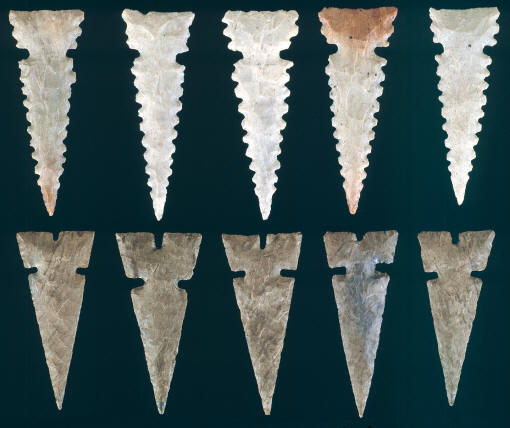
CLICK ON PICTURE FOR LARGER IMAGE
OWNED BY THE PEOPLE OF
ILLINOIS
DOUBLE-NOTCHED SERRATED &
TRIPLE-NOTCHED CAHOKIA POINTS
MOUND 72
A.D. 1000
CAHOKIA MOUNDS STATE HISTORIC
SITE
ST. CLAIR COUNTY, ILLINOIS
These points are identified by Fowler
as type IX double-notched serrated points at top and type I
triple-notched Cahokia points in the
bottom row. In all three caches there were only 39 double-notched
serrated type IX points. But the highest number of points are
represented by type I triple-notched Cahokia points. There were 429
examples found in the three caches. The longest point in this
picture measures approximately 1 7/8 inches (4.7 cm) long. The
points in the top row are made of a material that has not been
positively identified. The points in the bottom row are made of
either Elco or Dover/Fort Payne chert. |
|
|
Cache number 1970 contains a total of 451 arrow points.
Although this is the largest cache of points in Mound 72, it's represented by only
four different point types. The highest number of points in one type are represented
by 258 (type I) triple-notched serrated and un-serrated Cahokia points
made of white Burlington chert. The second largest number
is 178 (type VII) serrated Madison points, most of which are made of
Kaolin chert. The third largest number is
represented by 13 (type VIII) triple-notched serrated Cahokia points and
the fourth type is 2 (type IX) double-notched serrated Cahokia points. |
|

CLICK ON PICTURE FOR LARGER IMAGE
OWNED BY THE PEOPLE OF
ILLINOIS
SCALLORN POINTS &
"EXOTIC" FORM OF MOUND 72 POINTS
MOUND 72
A.D. 1000
CAHOKIA MOUNDS STATE HISTORIC
SITE
ST. CLAIR COUNTY, ILLINOIS
The top row in this picture are
classified as type X points in Fowler's report. They are all made of
Pitkin chert and 108 of them were found in cache number 1550. Ray
identifies them as Scallorn points. The five points in the bottom
row are type XI points. There were approximately 8 of these points
in cache number 1550. These types of fanciful "exotic" forms have
only been reported in Mound 72. All of them are made of brown kaolin chert. |
|
|
A fourth cache of
antler arrow points was also discovered in Mound 72. These points appear to be typical examples that have barbs on
their bases. From a photograph, the cache appears to contain well over a
hundred points. |
|
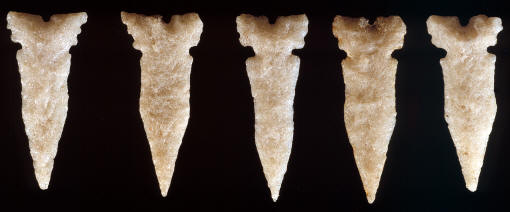
CLICK ON PICTURE FOR LARGER IMAGE
OWNED BY THE PEOPLE OF
ILLINOIS
"EXOTIC" FORM OF MOUND 72 POINTS
MOUND 72
A.D. 1000
CAHOKIA MOUNDS STATE HISTORIC
SITE
ST. CLAIR COUNTY, ILLINOIS
These arrow points have
been referred to by Fowler and Ray as Huffaker points or similar to
Huffaker points. If they are Huffaker points they are very stylized
versions of them. Huffaker points do not have the recurved and
angular blade edges that these points have. These points also have
multiple serrations on their bases. Huffaker points usually have
only one notch on the side basal edge. Fowlers places these points
in the type XI category. All of these points are made of either a
low grade of Hixton quartzite from Wisconsin or from another source
of quartzite that is reported to be much closer. Approximately 22
similar points made of this same
quartzite were found in cache number 1551. |
|
|
The most common point type found in the
Mound 72 collection are triple-notched serrated and un-serrated Cahokia
points that Fowler designates as type I. All three caches contain a good
number of them and total 429 points. Most of these points are made of
white Burlington chert. A very few of them are made of the
pink variety of High Ridge Burlington chert and either Elco or
Dover/Fort Payne chert. |
|
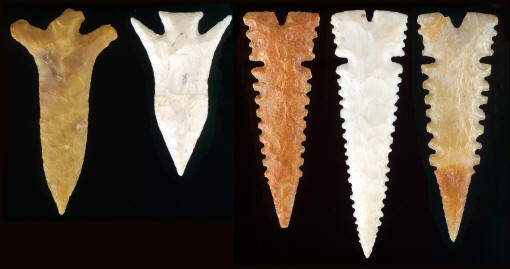
CLICK ON PICTURE FOR LARGER IMAGE
OWNED BY THE PEOPLE OF
ILLINOIS
MOUND 72 POINTS
A.D. 1000
CAHOKIA MOUNDS STATE HISTORIC
SITE
ST. CLAIR COUNTY, ILLINOIS
These five Mound 72 points have been
identified by Fowler as belonging to three different types. The
point on the left is identified as a type III point that was found
in cache number 1550. It's the only Agee point that was found in
Mound 72. Perino reports that Agee points have been found in
Arkansas, Oklahoma, Texas, and Louisiana. The second point from the
left is identified by Fowler as a type V point. He compares the
bases of these points to Sequoyah points but the recurved blade
edges are not at all similar to Sequoyah points. Only 14 of these
unique forms of arrow points are reported to have been found in
cache number 1550. The three points on the right are the longest
triple-notched serrated Cahokia points in the collection of Mound 72
points. They are either in Fowler's type I or type VIII categories.
Two of the points have large serrations that do not continue all the
way to the point. The point on the right is made of Kaolin chert and
measures 2 1/8 inches (5.4 cm) long. |
|
|
The second most common point type in all the collections of arrow points from
Mound 72 are serrated Madison
points. Serrated Madison points are found on habitation sites but they
are rare. So the largest collection of these points come from Mound 72.
Six different variations of the type are reported and total 326 points.
Over a hundred of them were made of Kaolin chert and others are made of
Burlington and Mill Creek cherts. |
|
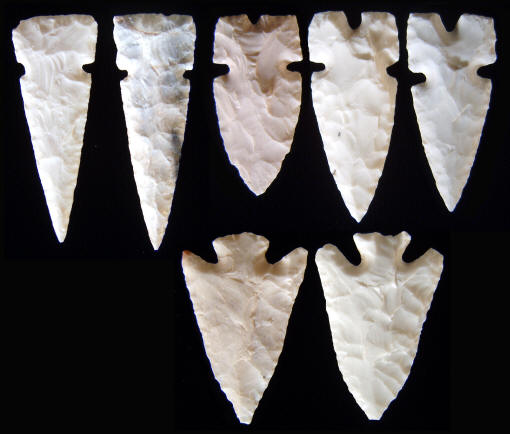
CLICK ON PICTURE FOR LARGER IMAGE
OWNED BY THE PEOPLE OF
ILLINOIS
MOUND 72
POINTS
A.D. 1000
CAHOKIA MOUNDS STATE HISTORIC
SITE
ST. CLAIR COUNTY, ILLINOIS
These seven points are identified as
three different types of Mound 72 points in Fowler's report. The two
double-notched points at the left in the top row are the only two
reported that have the very small notches. Fowler categorizes them
as a sub style in type IX. The three points to the right represents
type number II in the collection. Only four of these points were
found in cache number 1551. These points are thicker than most other
Cahokia points in the collection. Similar triple-notched points with
excurvate edges are reported from the Schild site in Greene County,
Illinois. These points are made of white Burlington chert. The two
corner notched points in the bottom row are identified by Fowler as
type IV points in the collection of Mound 72 points. There were only
three of these points found in cache number 1550. They are all made
of white Burlington chert. |
|
|
For craftsmanship, color and unique one-of-a-kind designs the Mound 72
points have few rivals. The collection is certainly the most
extraordinary group of arrow points that has ever been found in the area
around the Cahokia Mounds site. Many of the unique forms in the
collection have no previous comparative type examples in the
archaeological record. So they represent a rare insight into the
craftsman's freedom to produce fanciful and artistic forms that actually
combine different styles of points from distant locations. Special
events always seem to push an artists abilities to perform at the
highest level. In this case the flintknappers produced the best examples
of arrow points they could. The artisans pushed their flaking skill to
the limit and incorporated unique design patterns and selected good
quality and colorful stones. It's difficult to imagine how the different
people who made them could
have done a better job. |
|
"REFERENCES"
1973, Fowler, Melvin L.,
"Explorations Into Cahokia Archaeology," pp.18-26.
1985, Perino, Gregory, "Selected Preforms, Points and Knives of the
North American Indians," Cahokia Mound 72 Points, and Huffaker
Points, pp. 60 and 190.
1989, Fowler, Melvin L., "The Cahokia Atlas, A Historical Atlas
of Cahokia Archaeology," Mound 72 (S860E66, pp. 144-150.
1999, Fowler, Melvin L., Rose, Jerome, Leest, Barbara Vander & Ahler,
Steven R.,
"The
Mound 72 Area: Dedicated and Sacred Space in Early Cahokia," p. 101-115.
2004, Pauketat, Timothy R., "Ancient Cahokia And The
Mississippians," pp. 91 & 113.
2007, Ray, Jack H., "Ozarks Chipped-Stone Resources: A Guide To The
Identification, Distribution, And Prehistoric Use Of Cherts And Other
Siliceous Raw Materials," p. 202-204 & 246.
Personal Communication with Brad Koldehoff
|
|
RECENT
LISTINGS HOME
ORDERING |